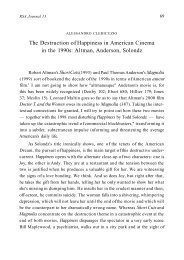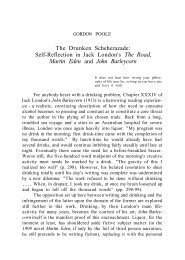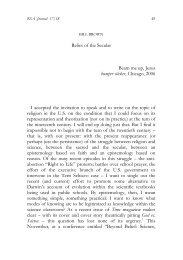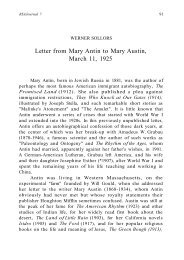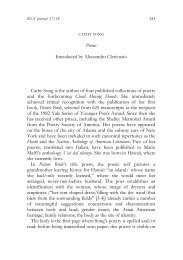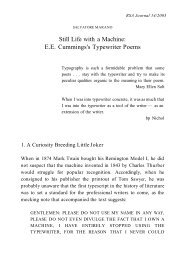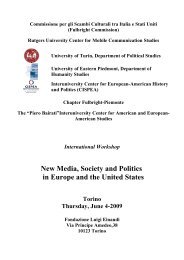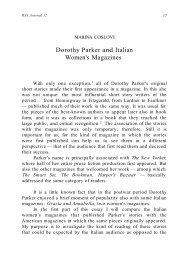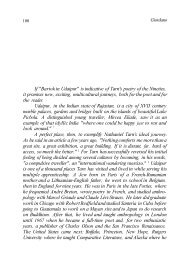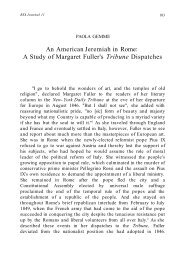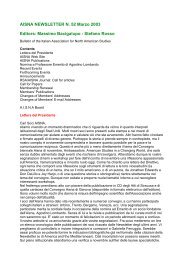Myth and Carnival in Robert Coover's The Public Burning - aisna
Myth and Carnival in Robert Coover's The Public Burning - aisna
Myth and Carnival in Robert Coover's The Public Burning - aisna
- No tags were found...
Create successful ePaper yourself
Turn your PDF publications into a flip-book with our unique Google optimized e-Paper software.
10 Da<strong>in</strong>ottoartifice <strong>and</strong> that, <strong>in</strong> so do<strong>in</strong>g, escape from hyposthasis <strong>in</strong>to" myth" <strong>and</strong>avoid foster<strong>in</strong>g any epistemological "discipl<strong>in</strong>e." <strong>The</strong>se new narrativeforms have been variously def<strong>in</strong>ed as "metafictional," "surfictional,"<strong>and</strong> "self-conscious"; Coover, for his part, prefers to talk of "ExemplaryFictions":Ejemplares you [Cervantes] called your tales, because your <strong>in</strong>tention was"poner en laplaza unamesa de nuestra republica, unamesa de trucos, dondecada uno pueda llegar a entratenerse s<strong>in</strong> daño del alma ni delcuerpo, porquelos ejercicios honestos y agreables antes aprovechan que dañan" (Coover1969, 77)If Cervantes's Novelas Ejemplares called <strong>in</strong>to question the statusof fictions <strong>and</strong> of themselves as fictions, they also affirmed theautonomy of the fiction-maker's "imag<strong>in</strong>ation" from Truth. Know<strong>in</strong>gthat a fiction is, after all, only a fiction, is potentially subversive of anygiven notion of "realism" <strong>and</strong> "mean<strong>in</strong>gfulness" that might have beenattributed to, <strong>and</strong> susta<strong>in</strong>ed by, previous literary artifacts. Exemplaritycan be described as a comic disruption of older forms <strong>and</strong> dogmas, atension both moral <strong>and</strong> ontological to underm<strong>in</strong>e a fixed notion ofreality. Coover says:Maybe the struggle I had as a young writer aga<strong>in</strong>st the old forms hadmade me overly aware of their restrictive nature, such that I foundmyself burdened with a vast number of metaphoric possibilities, all ofwhich were touched by this sense of dogma <strong>in</strong>vad<strong>in</strong>g the world <strong>and</strong>turn<strong>in</strong>g it to stone. (Coover 1983, 69)Caught <strong>in</strong> a quite Borgesian "Pierre Menard's paradox," <strong>Coover's</strong>rewrit<strong>in</strong>g of Cervantes's "exemplarity" is dest<strong>in</strong>ed to go much furtherthan Cervantes could have possibly foretold, because, for Coover, notonly the realist novel but the very notion of "reality" is an artificialconstruction: "every effort to form a view of the world <strong>in</strong>volves a k<strong>in</strong>dof fiction-mak<strong>in</strong>g process" (Coover 1983, 68). <strong>Coover's</strong> disruption ofold narrative forms co<strong>in</strong>cides with the disruption of a stable notion ofreality which legitimates, <strong>and</strong> is legitimated by, a "restrictive" socialstructure that sets the limits <strong>and</strong> the status of a given "reality."Significantly, <strong>The</strong> <strong>Public</strong> Burn<strong>in</strong>g focuses on a much wider body of"reality-mak<strong>in</strong>g processes" than novels conventionally do—or, for that



